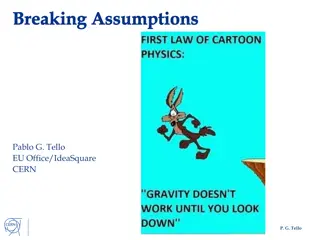
Exploring the Incredible World of Deep-Sea Physics and Pressure Effects
Delve into the fascinating realm of deep-sea physics and the impact of water pressure on objects submerged in the ocean. Discover how water pressure compresses air spaces, affecting items like a styrofoam head carried to depths of 3,000 meters. Learn about the adaptations of deep-sea animals to immense pressure, such as hydrostatic skeletons and collapsible lungs. Explore the unique challenges and wonders that exist below the ocean's surface.
Download Presentation

Please find below an Image/Link to download the presentation.
The content on the website is provided AS IS for your information and personal use only. It may not be sold, licensed, or shared on other websites without obtaining consent from the author. If you encounter any issues during the download, it is possible that the publisher has removed the file from their server.
You are allowed to download the files provided on this website for personal or commercial use, subject to the condition that they are used lawfully. All files are the property of their respective owners.
The content on the website is provided AS IS for your information and personal use only. It may not be sold, licensed, or shared on other websites without obtaining consent from the author.
E N D
Presentation Transcript
Thinking Sinking George Feldman, Megan McCall
What happens when you go down below the ocean? Deep sea physics: Water pressure and the incredible shrinking head To illustrate the effect of water pressure on air spaces in the deep sea, a styrofoam head was carried by a submarine, from the surface down into the ocean to 3,000 meters (9,840 feet). Water pressure increases with depth, compressing the tiny air pockets in the styrofoam, and causing the head to shrink. At a depth of 3,000 meters, the pressure is 300 times that on the surface, and presses about 4,400 pounds on every square inch of the head. It would feel like having a 4,400-pound adult hippopotamus sitting on your thumb! Because water is less compressible than air, deep-sea animals often have hydrostatic skeletons (skeletons that are supported by fluid pressure) and lack air spaces in their bodies. Deep-diving mammals, such as elephant seals, have adapted to the immense pressure in the deep waters where they hunt, by having collapsible lungs that press out all the air as they are diving down to depths of up to 2,000 meters! Video producer: Linda Kuhnz Any animal that lives under the ocean has to be under this kind of pressure. https://www.mbari.org/products/video-library/
Now go outside and inflate the bike tire 14 psi per 33 feet you walk. Okay, the real story- the ocean exerts an increase of 14.7psi (1 atmosphere) per 10m, pressure squeezes you, not the other way around, you are already under 1 atmosphere of pressure. Now go learn outside!
Making a diorama 1. Create a scale on the back of a file folder, and open it vertically. 2. Mark where one of your animals would live in the vertical. 3. Attach a picture of the animal there. Vampyroteuthis infernalis(Chun, 2001). The Deep-Sea Guide (DSG) at http://dsg.mbari.org. Monterey Bay Aquarium Research Institute (MBARI). Consulted on: 2018-06-28 File- George Feldman, 2018
Using Deep-Sea Guide Log onto MBARI Deep- Sea Guide Enter the animal name and find an image Select (Data Products) Select (Greater Monterey Bay) from dropdown menu to find depth information from graph






















